Abstract
Blood samples from 32 groups of calves (n = 700) were taken on arrival and after 28-35 days at the feedlot. Eleven groups were housed in feedlots in Ontario, and 21 groups in feedlots in Alberta. Serum antibody titers to bovine viral diarrhea virus (BVDV), bovine respiratory syncytial virus (BRSV), parainfluenza virus type 3 (PIV-3), infectious bovine rhinotracheitis virus (IBRV), Mycoplasma dispar and M. bovis, plus data on bovine corona virus (BCV) from a previous study were investigated for their association with the risk of bovine respiratory disease (BRD), and with 28-day weight change, both before and after controlling for titers to Pasteurella haemolytica and Haemophilus somnus. Exposure to IBRV and M. bovis was infrequent, and although exposure to PIV-3 was more common, none of these agents had important associations with BRD. Higher titers to BVDV, BRSV, and BCV on arrival were associated with reduced risks of BRD and increased weight gains. However, there was some variation in these relationships and higher arrival titers to BVDV and BRSV in a subset of the calves were associated with increased risks of BRD. Titer increases to BVDV were associated with a higher risk of BRD and lower weight gains. Titer increases to BRSV were not usually associated with the occurrence of BRD, but titer increases to BRSV in a subset of calves that were vaccinated against BRSV, on arrival, were associated with an elevated risk of BRD. Of all the agents studied, BVDV had the most consistent associations with elevated risk of BRD and lower weight gains. Higher BRSV arrival titers were related to lower risk of BRD and higher weight gains; in some instances titer increases to BRSV were associated with higher BRD risk. Higher titers to BCV on arrival were related to reduced risks of BRD. Practical ways of adequately preventing the negative effects of these agents are still needed.
Full text
PDF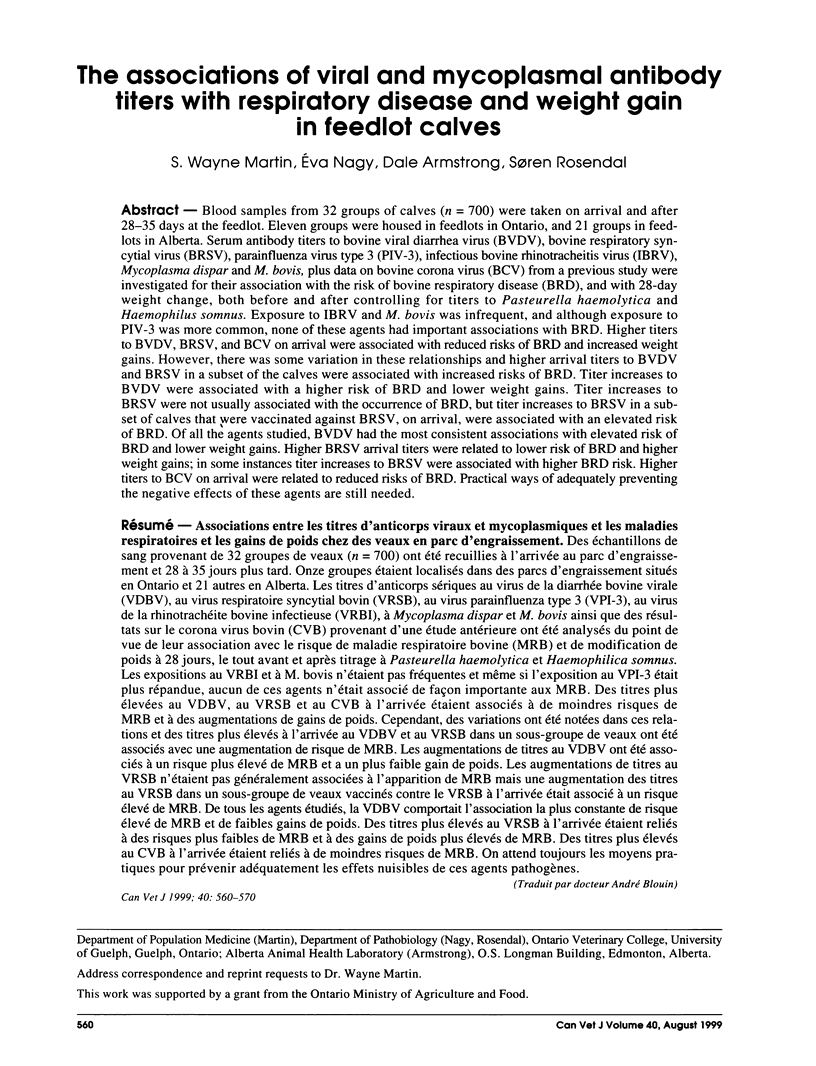
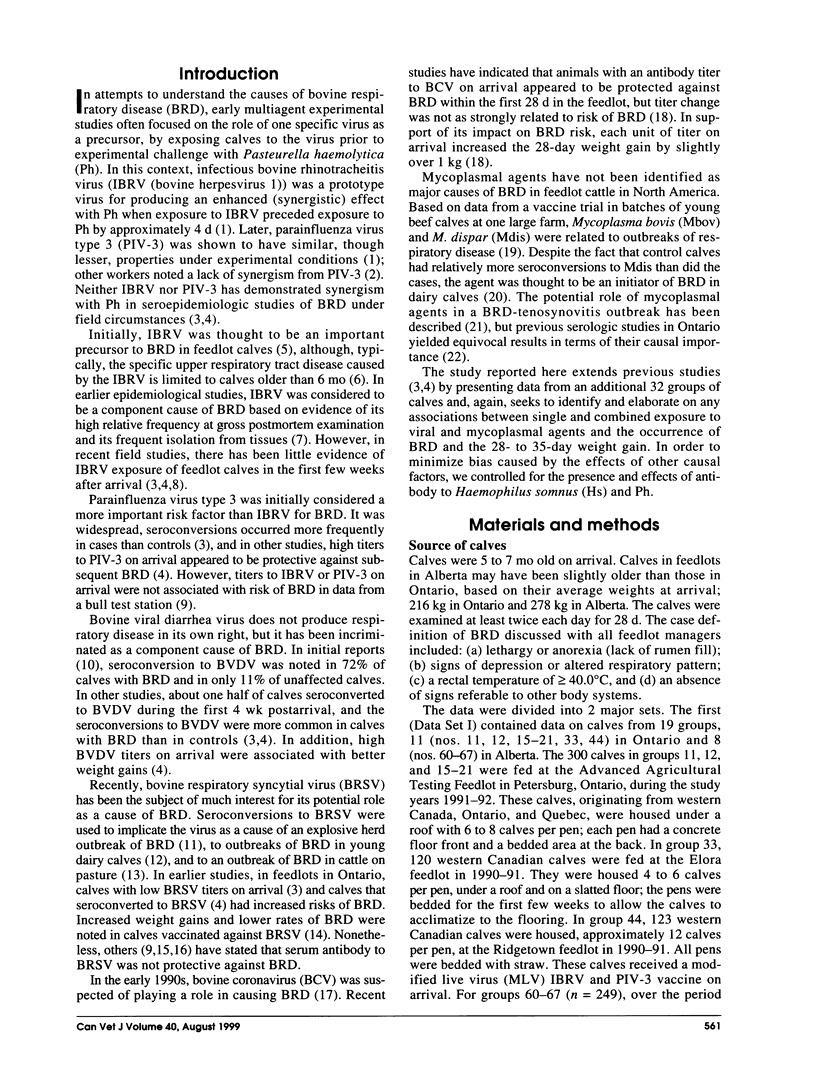


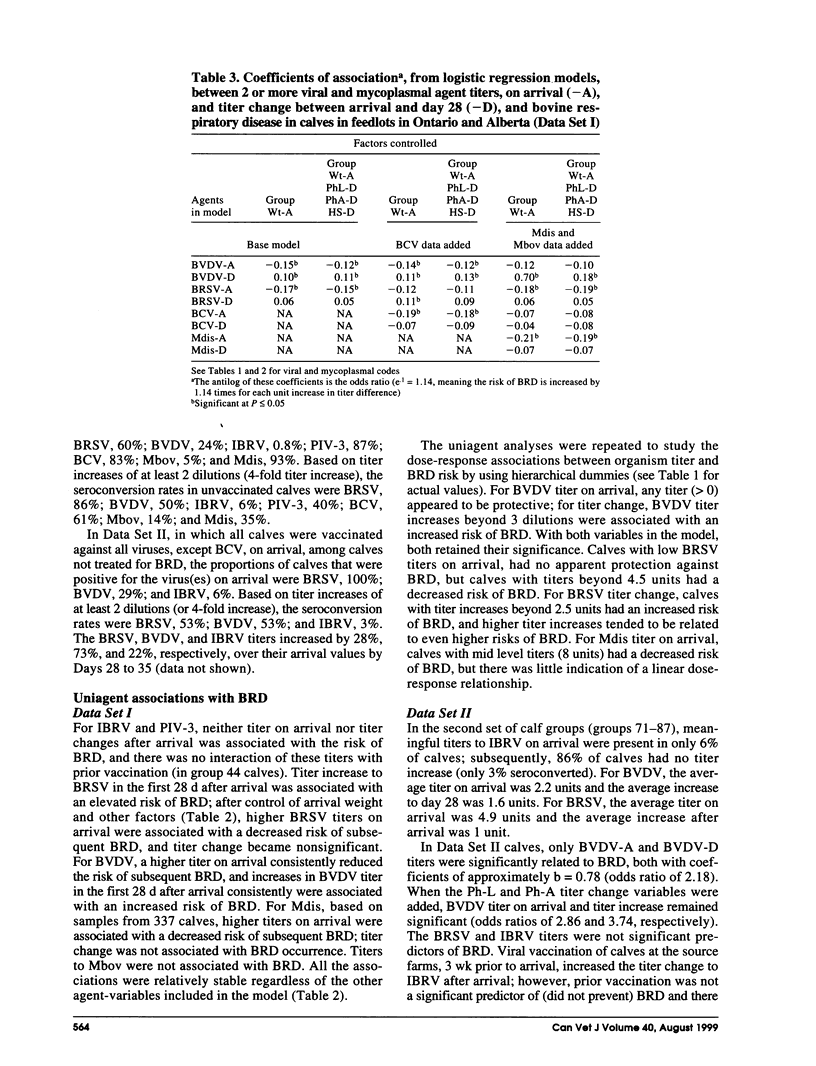
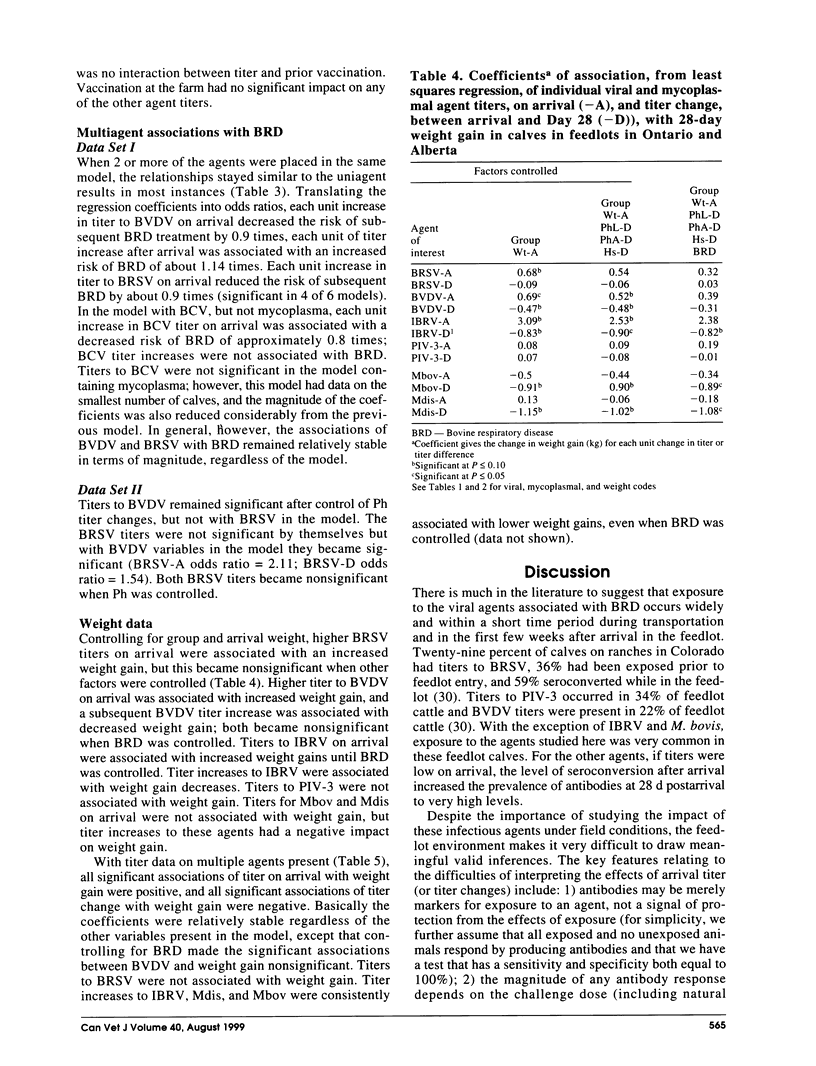
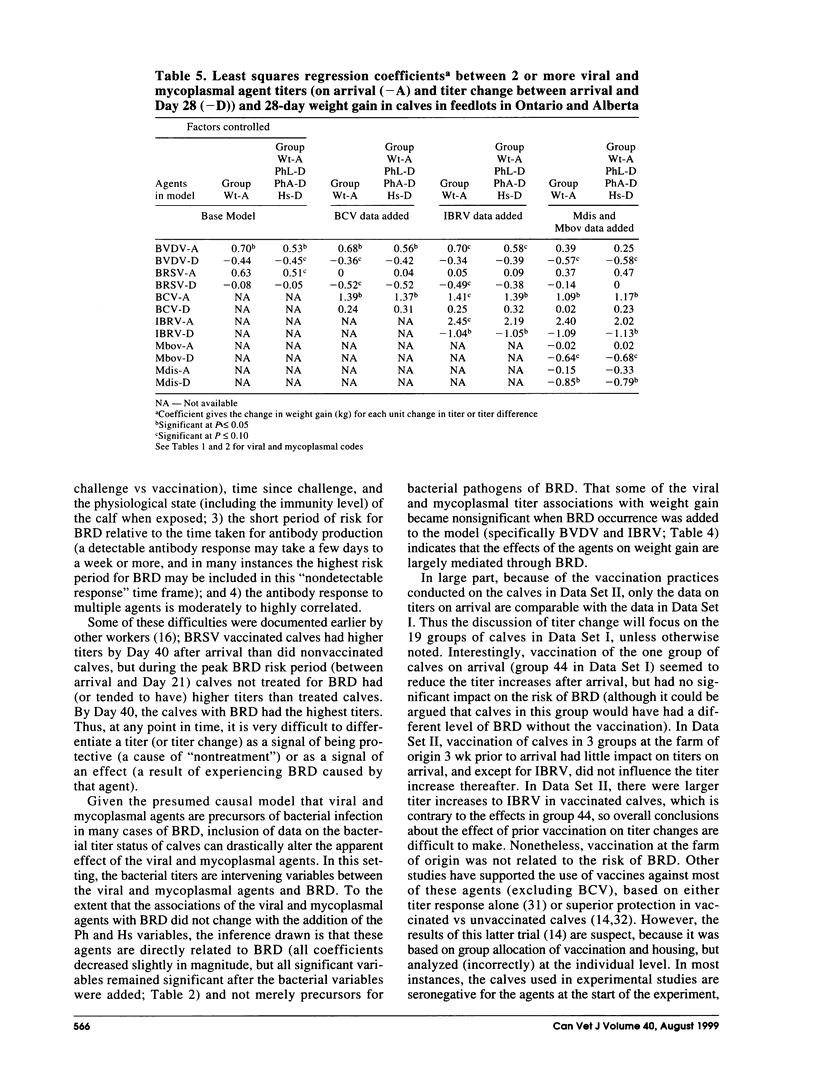
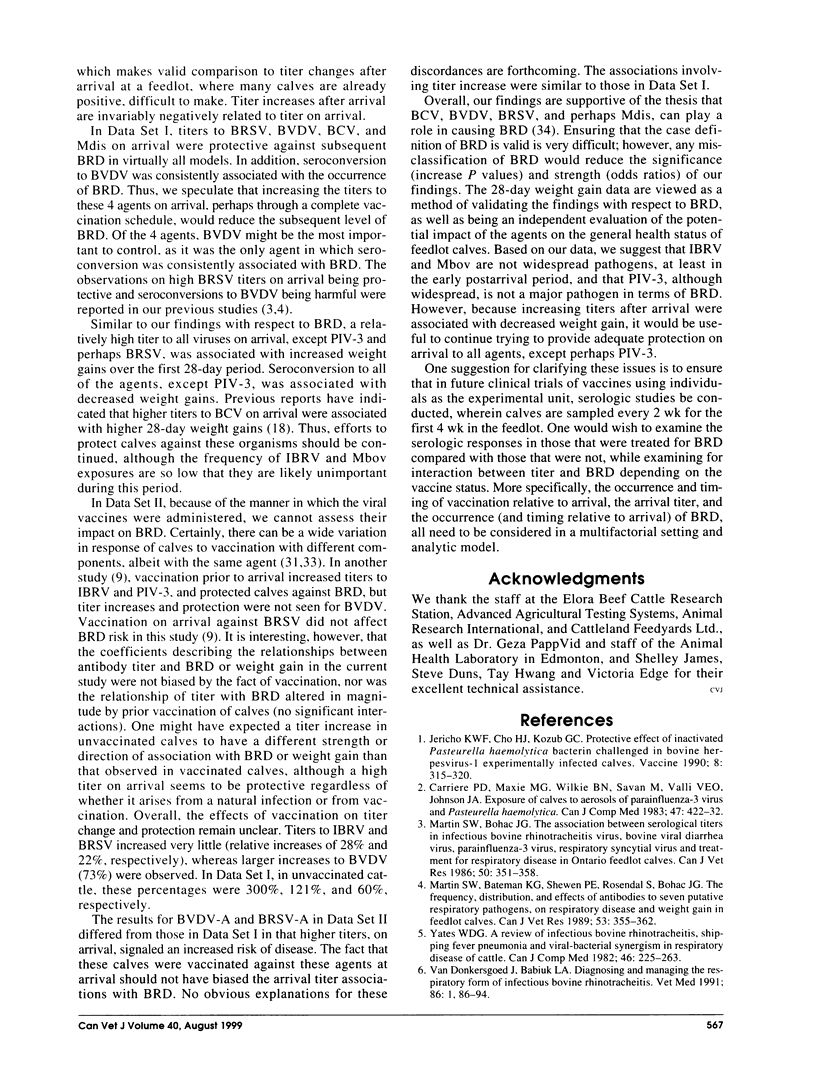

Selected References
These references are in PubMed. This may not be the complete list of references from this article.
- Adegboye D. S., Halbur P. G., Nutsch R. G., Kadlec R. G., Rosenbusch R. F. Mycoplasma bovis-associated pneumonia and arthritis complicated with pyogranulomatous tenosynovitis in calves. J Am Vet Med Assoc. 1996 Aug 1;209(3):647–649. [PubMed] [Google Scholar]
- Allen J. W., Viel L., Bateman K. G., Nagy E., Røsendal S., Shewen P. E. Serological titers to bovine herpesvirus 1, bovine viral diarrhea virus, parainfluenza 3 virus, bovine respiratory syncytial virus and Pasteurella haemolytica in feedlot calves with respiratory disease: associations with bacteriological and pulmonary cytological variables. Can J Vet Res. 1992 Oct;56(4):281–288. [PMC free article] [PubMed] [Google Scholar]
- Carman P. S., Hazlett M. J. Bovine coronavirus infection in Ontario 1990-1991. Can Vet J. 1992 Dec;33(12):812–814. [PMC free article] [PubMed] [Google Scholar]
- Carrière P. D., Maxie M. G., Wilkie B. N., Savan M., Valli V. E., Johnson J. A. Exposure of calves to aerosols of parainfluenza-3 virus and Pasteurella haemolytica. Can J Comp Med. 1983 Oct;47(4):422–432. [PMC free article] [PubMed] [Google Scholar]
- Clark T., Fenton R. A. Alberta. Interstitial pneumonia associated with Bovine Respiratory Syncytial Virus in a grazing reserve. Can Vet J. 1988 May;29(5):459–460. [PMC free article] [PubMed] [Google Scholar]
- Collins J. K., Teegarden R. M., MacVean D. W., Salman, Smith G. H., Frank G. R. Prevalence and specificity of antibodies to bovine respiratory syncytial virus in sera from feedlot and range cattle. Am J Vet Res. 1988 Aug;49(8):1316–1319. [PubMed] [Google Scholar]
- Durham P. J., Hassard L. E. Prevalence of antibodies to infectious bovine rhinotracheitis, parainfluenza 3, bovine respiratory syncytial, and bovine viral diarrhea viruses in cattle in Saskatchewan and Alberta. Can Vet J. 1990 Dec;31(12):815–820. [PMC free article] [PubMed] [Google Scholar]
- Evans A. S. Causation and disease: a chronological journey. The Thomas Parran Lecture. Am J Epidemiol. 1978 Oct;108(4):249–258. doi: 10.1093/oxfordjournals.aje.a112617. [DOI] [PubMed] [Google Scholar]
- Fulton R. W., Confer A. W., Burge L. J., Perino L. J., d'Offay J. M., Payton M. E., Mock R. E. Antibody responses by cattle after vaccination with commercial viral vaccines containing bovine herpesvirus-1, bovine viral diarrhea virus, parainfluenza-3 virus, and bovine respiratory syncytial virus immunogens and subsequent revaccination at day 140. Vaccine. 1995;13(8):725–733. doi: 10.1016/0264-410x(94)00072-u. [DOI] [PubMed] [Google Scholar]
- Harland R. J., Potter A. A., van Drunen-Littel-van den Hurk S., Van Donkersgoed J., Parker M. D., Zamb T. J., Janzen E. D. The effect of subunit or modified live bovine herpesvirus-1 vaccines on the efficacy of a recombinant Pasteurella haemolytica vaccine for the prevention of respiratory disease in feedlot calves. Can Vet J. 1992 Nov;33(11):734–741. [PMC free article] [PubMed] [Google Scholar]
- Jericho K. W., Cho H. J., Kozub G. C. Protective effect of inactivated Pasteurella haemolytica bacterin challenged in bovine herpesvirus-1 experimentally infected calves. Vaccine. 1990 Aug;8(4):315–320. doi: 10.1016/0264-410x(90)90087-3. [DOI] [PubMed] [Google Scholar]
- Kimman T. G., Zimmer G. M., Westenbrink F., Mars J., van Leeuwen E. Epidemiological study of bovine respiratory syncytial virus infections in calves: influence of maternal antibodies on the outcome of disease. Vet Rec. 1988 Jul 23;123(4):104–109. doi: 10.1136/vr.123.4.104. [DOI] [PubMed] [Google Scholar]
- Martin S. W., Bateman K. G., Shewen P. E., Rosendal S., Bohac J. E. The frequency, distribution and effects of antibodies, to seven putative respiratory pathogens, on respiratory disease and weight gain in feedlot calves in Ontario. Can J Vet Res. 1989 Jul;53(3):355–362. [PMC free article] [PubMed] [Google Scholar]
- Martin S. W., Bohac J. G. The association between serological titers in infectious bovine rhinotracheitis virus, bovine virus diarrhea virus, parainfluenza-3 virus, respiratory syncytial virus and treatment for respiratory disease in Ontario feedlot calves. Can J Vet Res. 1986 Jul;50(3):351–358. [PMC free article] [PubMed] [Google Scholar]
- Martin S. W., Meek A. H., Davis D. G., Thomson R. G., Johnson J. A., Lopez A., Stephens L., Curtis R. A., Prescott J. F., Rosendal S. Factors associated with mortality in feedlot cattle: the Bruce County Beef Cattle Project. Can J Comp Med. 1980 Jan;44(1):1–10. [PMC free article] [PubMed] [Google Scholar]
- Martin S. W., Nagy E., Shewen P. E., Harland R. J. The association of titers to bovine coronavirus with treatment for bovine respiratory disease and weight gain in feedlot calves. Can J Vet Res. 1998 Oct;62(4):257–261. [PMC free article] [PubMed] [Google Scholar]
- Rosendal S., Martin S. W. The association between serological evidence of mycoplasma infection and respiratory disease in feedlot calves. Can J Vet Res. 1986 Apr;50(2):179–183. [PMC free article] [PubMed] [Google Scholar]
- Scott P. R., McGowan M., Sargison N. D., Penny C. D., Lowman B. G. Use of tilmicosin in a severe outbreak of respiratory disease in weaned beef calves. Aust Vet J. 1996 Feb;73(2):62–64. doi: 10.1111/j.1751-0813.1996.tb09967.x. [DOI] [PubMed] [Google Scholar]
- Shewen P. E., Wilkie B. N. Vaccination of calves with leukotoxic culture supernatant from Pasteurella haemolytica. Can J Vet Res. 1988 Jan;52(1):30–36. [PMC free article] [PubMed] [Google Scholar]
- Stewart R. S., Gershwin L. J. Systemic and secretory antibody responses to sequential bovine respiratory syncytial virus infections in vaccinated and nonvaccinated calves. Am J Vet Res. 1990 Oct;51(10):1596–1602. [PubMed] [Google Scholar]
- Stott E. J., Thomas L. H., Howard C. J., Gourlay R. N. Field trial of a quadrivalent vaccine against calf respiratory disease. Vet Rec. 1987 Oct 10;121(15):342–347. doi: 10.1136/vr.121.15.342. [DOI] [PubMed] [Google Scholar]
- Talens L. T., Beckenhauer W. H., Thurber E. T., Cooley A. J., Schultz R. D. Efficacy of viral components of a nonabortigenic combination vaccine for prevention of respiratory and reproductive system diseases in cattle. J Am Vet Med Assoc. 1989 May 1;194(9):1273–1280. [PubMed] [Google Scholar]
- Thorlakson B., Martin W., Peters D. A field trial to evaluate the efficacy of a commercial Pasteurella haemolytica bacterial extract in preventing bovine respiratory disease. Can Vet J. 1990 Aug;31(8):573–579. [PMC free article] [PubMed] [Google Scholar]
- Tollis M., Di Trani L., Cordioli P., Vignolo E., Di Pasquale I. Serological responses in calves to vaccines against bovine respiratory syncytial, infectious bovine rhinotracheitis, bovine viral diarrhoea and parainfluenza-3 viruses. Dev Biol Stand. 1996;86:147–156. [PubMed] [Google Scholar]
- Van Donkersgoed J., Janzen E. D., Townsend H. G., Durham P. J. Five field trials on the efficacy of a bovine respiratory syncytial virus vaccine. Can Vet J. 1990 Feb;31(2):93–100. [PMC free article] [PubMed] [Google Scholar]
- Virtala A. M., Mechor G. D., Gröhn Y. T., Erb H. N., Dubovi E. J. Epidemiologic and pathologic characteristics of respiratory tract disease in dairy heifers during the first three months of life. J Am Vet Med Assoc. 1996 Jun 15;208(12):2035–2042. [PubMed] [Google Scholar]
- Walter S. D., Feinstein A. R., Wells C. K. Coding ordinal independent variables in multiple regression analyses. Am J Epidemiol. 1987 Feb;125(2):319–323. doi: 10.1093/oxfordjournals.aje.a114532. [DOI] [PubMed] [Google Scholar]
- Yates W. D. A review of infectious bovine rhinotracheitis, shipping fever pneumonia and viral-bacterial synergism in respiratory disease of cattle. Can J Comp Med. 1982 Jul;46(3):225–263. [PMC free article] [PubMed] [Google Scholar]


